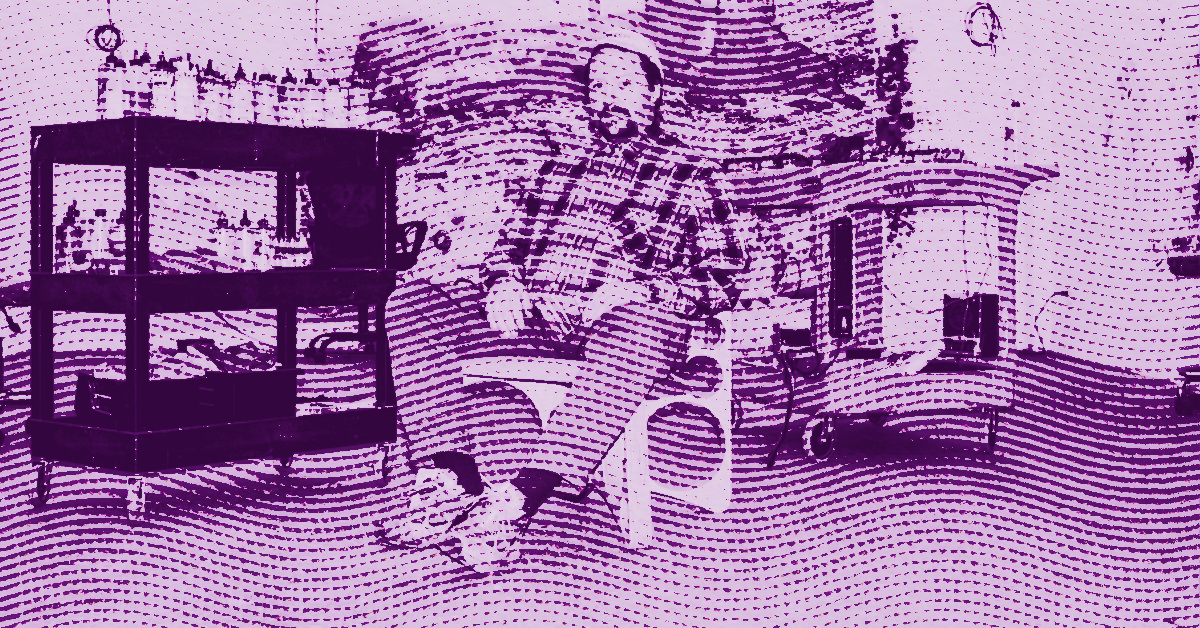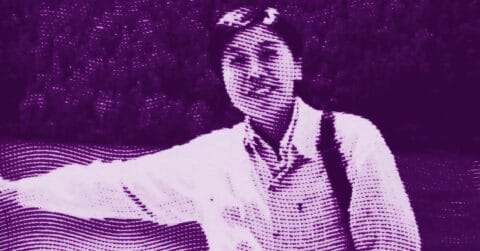Listen to me carefully, you bunch of snobs: here is an artist who refuses to look away in the face of the ordinary apocalypse of our contemporary metropolises. Sayre Gomez, master of Californian hyperrealism, confronts us with a truth we prefer to ignore behind our screens and Instagram filters. His canvases, with astonishing technical precision, reveal the poetry hidden in the detritus of our consumerist civilization. Every brushstroke, every flicker of failing neon, every peeled-off sticker testifies to a humanity surviving in the interstices of late capitalism.
Gomez’s work revolves around a fundamental paradox: how can a perfect illusion reveal a truth more authentic than reality itself? His paintings, created with an airbrush using techniques borrowed from Hollywood decorators, transform Los Angeles urban landscapes into contemporary allegories. In Palm Tower, this antenna disguised as a palm tree under a Tiepolo-worthy sky, the artist exposes the masquerade of our technological infrastructure. Pictorial sublimity meets industrial banality in a friction that generates deep unease, a sensation of catastrophic imminence that runs throughout his work.
This aesthetic of disillusionment finds its roots in a particularly rich European literary tradition. Gomez’s approach irresistibly evokes the world of J.G. Ballard, the explorer of late modernity’s pathologies. Like the British author in his urban speculative novels, Gomez reveals how our environments shape our collective psyche. The abandoned shopping malls, decrepit billboards, and burned-out cars in his paintings recall Ballard’s mental landscapes, where technology and consumerist desire generate new forms of alienation. In Crash or Crystal World, Ballard already described this aestheticization of urban violence that Gomez materializes in his carefully orchestrated compositions [1].
The artist shares with the writer a fascination for liminal spaces, those zones where civilization reveals its cracks. His paintings of closed stores, vacant lots scattered with trash, and failing signage constitute psychogeographical territories where the tensions of our time crystallize. Ballard called his work “speculative fiction” to describe his explorations of probable futures; Gomez practices “speculative painting” that reveals the hidden presents of our metropolises. Their respective works operate by accumulating apparently trivial details that, once assembled, draw a ruthless portrait of our contemporary condition.
This critical dimension of Gomez’s art is also illuminated by his relationship to cinematic imagery, particularly dystopian science fiction cinema. The influence of the seventh art on his practice goes beyond mere aesthetic reference to become an operational mode. His canvases function like immobile tracking shots, freeze frames extracted from an invisible film documenting the demise of the American Dream. This cinematic approach is manifested in his mastery of light, precise framing, and ability to create narrative tension from static elements.
Gomez’s work particularly dialogues with the aesthetics of film noir and B-movie cinema from the 1950s and 1960s, productions that already explored the shadowy areas of the American dream. Like in the films of Don Siegel or Samuel Fuller, his paintings reveal an underground America, that of the left-behind and deprived spaces. His nocturnal compositions, bathed in pale neon and artificial lighting, evoke the expressionist imagery of film noir while updating it in the context of the contemporary metropolis.
Moreover, Gomez aligns with the lineage of pessimistic science fiction cinema, from Ridley Scott’s Blade Runner to John Carpenter’s films. His urban landscapes share with these works a twilight vision of modernity, where technology, far from liberating humanity, subjects it to new forms of oppression. The telecommunications towers disguised as vegetation, the omnipresent screens, and the degraded infrastructures in his paintings evoke dystopian futures where the boundary between the organic and the artificial dangerously fades.
Gomez’s treatment of color also borrows from the chromatic vocabulary of fantasy and horror cinema. His sunsets with chemical hues, saturated neon lighting, and apocalyptic skies recall the visual palette of films like Dario Argento’s Suspiria or Panos Cosmatos’ Mandy. This expressionist colorimetry transforms the banal into the unsettling, the familiar into the menacing, revealing the hidden potentials of horror lurking in our urban daily lives.
The artist develops a visual grammar that borrows from genre cinema codes to transform documentary reality into a disturbing aesthetic experience. His composition techniques, inherited from Hollywood set decorators, create a hyperreality that reveals the mechanisms of construction of our collective imaginations. Every detail of his canvases is calculated with the precision of a director of photography, every lighting effect conceived as a narrative element. This cinematic approach to painting allows Gomez to go beyond mere representation to create truly immersive environments.
The influence of cinema on his work also shows in his serial conception of creation. Like a director developing a coherent film universe through several works, Gomez methodically constructs a personal mythology of Los Angeles. His series X-Scapes, Halloween City, or Heaven ‘N’ Earth function like episodes of a visual saga that maps the mutations of the Californian metropolis. This serial approach allows him to deepen his thematic obsessions while varying the angles of approach, creating a corpus of remarkable narrative coherence.
Gomez’s technical precision, far from being a mere tour de force, constitutes an aesthetic and political stance. In an era where digital imagery has normalized visual manipulation, his return to the artisanal expertise of the airbrush asserts the persistence of the human hand against automation. His sculptures of parking bollards, meticulously reproduced from recycled materials, question our relationship to authenticity in a world saturated with simulacra.
This quest for hyperreality paradoxically reveals the artificiality of our contemporary environments. By faithfully replicating the degraded textures, scratched surfaces, and faded colors of his urban subjects, Gomez exposes the processes of wear and deterioration that affect our living spaces. His canvases become archives of decay, testimonies to the fragility of our human constructions facing time and the elements.
The artist also develops a profound reflection on the visual codes of contemporary representation. His paintings of shop windows, with their complex reflections and layered surfaces, question our perception of reality in the age of omnipresent screens. As he himself states: “Photography can no longer present the truth objectively. I like the idea of trying to understand the truth or find it in an indirect way. The truth is something subjective” [2].
This awareness of the inherent subjectivity in all representation places Gomez in a critical position towards the documentary claims of contemporary art. His compositions, carefully orchestrated from disparate elements drawn from his personal photographic archive and digital image banks, fully assume their constructed nature. This post-photographic approach reveals the mechanisms behind the production of our visual imaginaries while questioning the truth value attributed to the image.
Gomez’s work gains a particularly relevant sociological dimension in the contemporary American context. His representations of urban poverty, the homeless, and neglected spaces bear witness to the social fractures that cross Californian society. Far from any compassionate voyeurism, his canvases reveal with clinical coldness the mechanisms of exclusion and marginalization operating in our metropolises.
This documentary approach finds its strength in its ability to reveal the extraordinary in the ordinary, the spectacular in the trivial. His paintings of abandoned shopping centers, vacant lots, and wrecked vehicles transform the symptoms of the urban crisis into unsettling aesthetic objects. This aestheticization of social misery might seem problematic, but Gomez avoids the pitfall of complacency through the rigor of his approach and the critical distance he maintains towards his subjects.
His sculptures of mannequins and everyday objects, painted in saturated monochromes, question the mechanisms of commercial fetishization that govern our consumer societies. These familiar objects, frozen in their colorful shell, become relics of a future civilization, archaeological vestiges of our consumerist present. This museographic approach reveals the planned obsolescence that affects not only our objects but also our living spaces and social relations.
The artist develops an aesthetic of contemporary ruin that reveals the cycles of destruction and reconstruction that rhythm urban evolution. His representations of construction sites, demolitions, and industrial wastelands testify to the creative violence of capitalism, its ability to perpetually transform urban space according to economic fluctuations. This geography of instability reveals the mechanisms of primitive accumulation that continue to operate in our contemporary metropolises.
Sayre Gomez’s work constitutes an essential testimony on our era, an unflinching mirror held up to our collective illusions. His paintings, of a troubling beauty, reveal the poetry hidden in the rubble of our late modernity. They remind us that authentic art often arises from confrontation with what we prefer to ignore, in those shadowy areas where the contradictions of our time are revealed. Faced with technological acceleration and the increasing dematerialization of our experiences, Gomez reaffirms the necessity to truly look, to take the time for observation and contemplation. His paradoxical hyperrealism invites us to rediscover the complexity of reality, beyond media simplifications and digital filters that shape our contemporary perception.
- J.G. Ballard, Crash (1973) and Concrete Island (1966), novels exploring the psychological mutations induced by technological and urban environments.
- Interview with Sayre Gomez, GQ Magazine, February 2024.
















